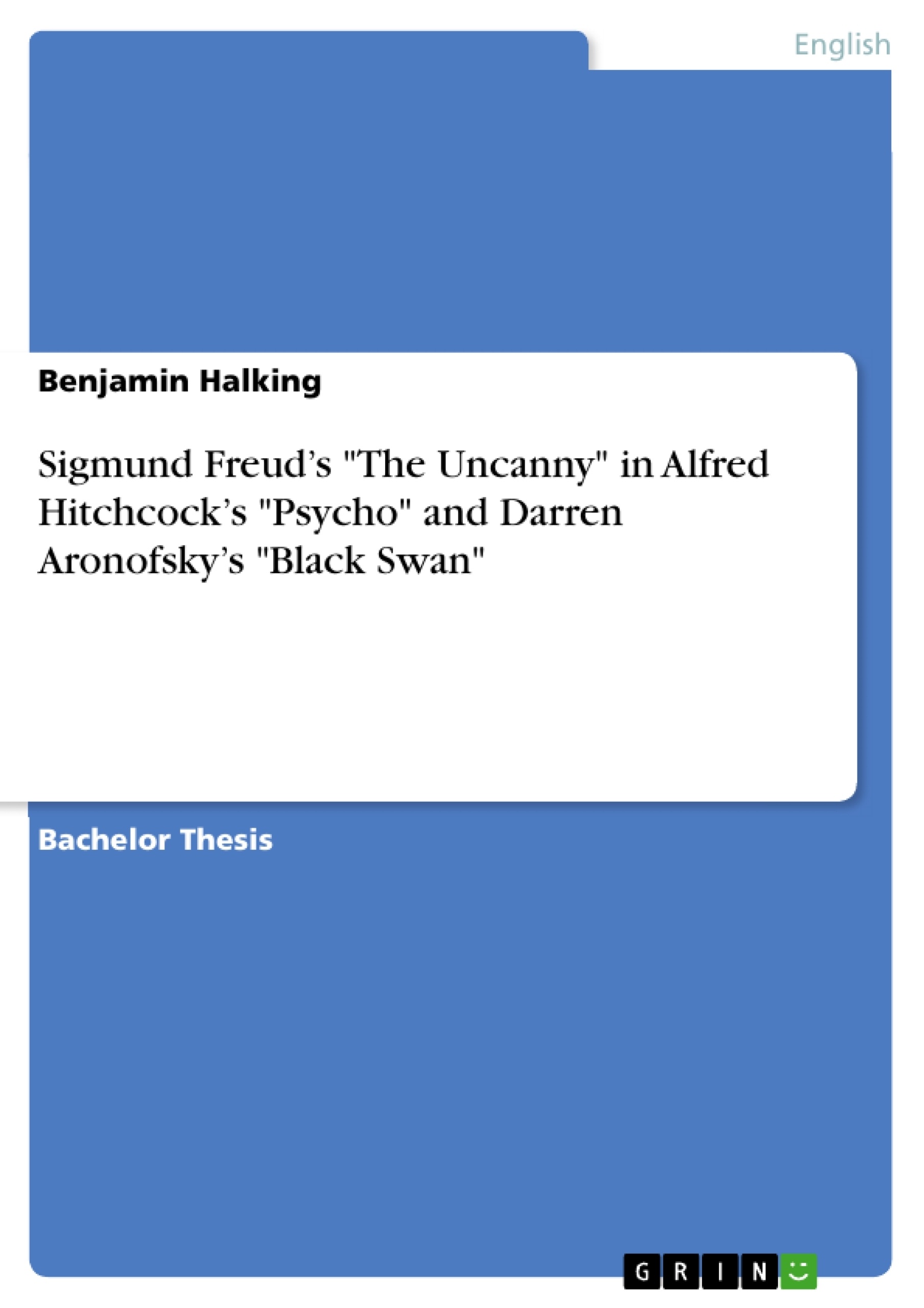This paper will revolve around Sigmund Freud’s The Uncanny and the momentum of suspense it can cause.
Furthermore, an interview of Alfred Hitchcock will be looked at in excerpts, where he discusses the momentum of suspense. Subsequently, the theory of The Uncanny will be applied to Alfred Hitchcock’s 1960 movie Psycho and later to Darren Aronofsky’s 2010 movie Black Swan. Psycho sets an example of the suspense and is inevitably connected to the name of Alfred Hitchcock.
Why is Psycho the embodiment of suspense and the uncanny? Opposed to Hitchcock’s masterpiece, the 2010 movie Black Swan will be looked at in terms of the uncanny. As this movie is considered to be “an uncanny representation of light and color”, it is supposed to form the counterpart to Hitchcock’s Psycho in terms of uncanny elements and the idea of suspense. These seemingly very diverse genres (the titles themselves give off different expectations already) shall be examined regarding the use of uncanny elements. It will be analyzed how these elements are used and what the degree and frequency of the uncanny does to both the movie and the viewer.
This paper aims to correlate the amount, the frequency and the intensity of uncanny elements with the suspense that is built throughout both of the movies. Does the amount of uncanny do any harm to the idea of suspense? Is this idea following the principle of “the more the better” or rather “less is more”? The current status of research on this very matter is very scarce. Aside from the interview of Truffaut with Alfred Hitchcock himself, there appears to be no hard evidence that this matter has been dealt with. Only Hitchcock goes into this topic and explains what he fathoms by suspense and how to build it (through uncanny elements).
Inhaltsverzeichnis (Table of Contents)
- Introduction
- Freud's The Uncanny
- Diversifications of The Uncanny
- Exemptions
- Theory of Suspense
- The Uncanny in Movies and Literature
- Hitchcock's Psycho
- Aronofsky's Black Swan
- Conclusion
- Works consulted and quoted
- Appendix
Zielsetzung und Themenschwerpunkte (Objectives and Key Themes)
This paper aims to examine the concept of the uncanny, as defined by Sigmund Freud, in relation to the creation of suspense in cinema, specifically in Alfred Hitchcock's Psycho and Darren Aronofsky's Black Swan. The paper will analyze the uncanny elements in both films and explore how these elements contribute to the overall sense of suspense.
- Sigmund Freud's theory of the uncanny
- The role of suspense in cinema
- The relationship between the uncanny and suspense
- Analysis of the uncanny elements in Psycho and Black Swan
- The impact of uncanny elements on the viewer
Zusammenfassung der Kapitel (Chapter Summaries)
- Introduction: This chapter introduces the topic of the uncanny and its connection to suspense in film. It uses examples from popular culture to illustrate the concept of the uncanny and its ability to evoke feelings of unease and discomfort.
- Freud's The Uncanny: This chapter explores Freud's theory of the uncanny, focusing on its origins and various manifestations. It discusses the ambiguity of the term "uncanny" and its connection to the familiar and the unfamiliar.
- Theory of Suspense: This chapter delves into the theory of suspense in film, examining the techniques used by filmmakers to create suspenseful moments. It analyzes the relationship between suspense and the uncanny, arguing that the uncanny can play a crucial role in building suspense.
- The Uncanny in Movies and Literature: This chapter examines the use of uncanny elements in two specific films, Psycho and Black Swan. It analyzes how the films use the uncanny to create suspense and evoke particular emotions in the viewer.
Schlüsselwörter (Keywords)
This paper explores the themes of the uncanny, suspense, and the relationship between these two concepts in the context of cinema. It examines key elements like Freud's theory of the uncanny, the use of suspense in filmmaking, and the role of uncanny elements in building suspense in films like Psycho and Black Swan. The paper aims to contribute to the understanding of how the uncanny contributes to the overall experience of watching films and its impact on the viewer.
- Quote paper
- Benjamin Halking (Author), 2016, Sigmund Freud’s "The Uncanny" in Alfred Hitchcock’s "Psycho" and Darren Aronofsky’s "Black Swan", Munich, GRIN Verlag, https://www.grin.com/document/1284554



